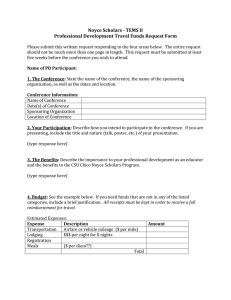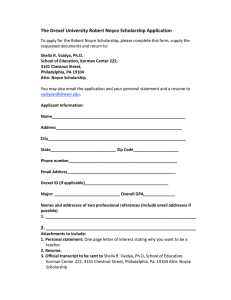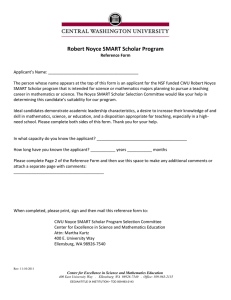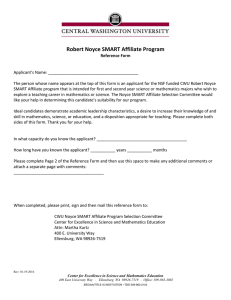Robert Noyce Scholarship Program – Auburn University – Final
advertisement
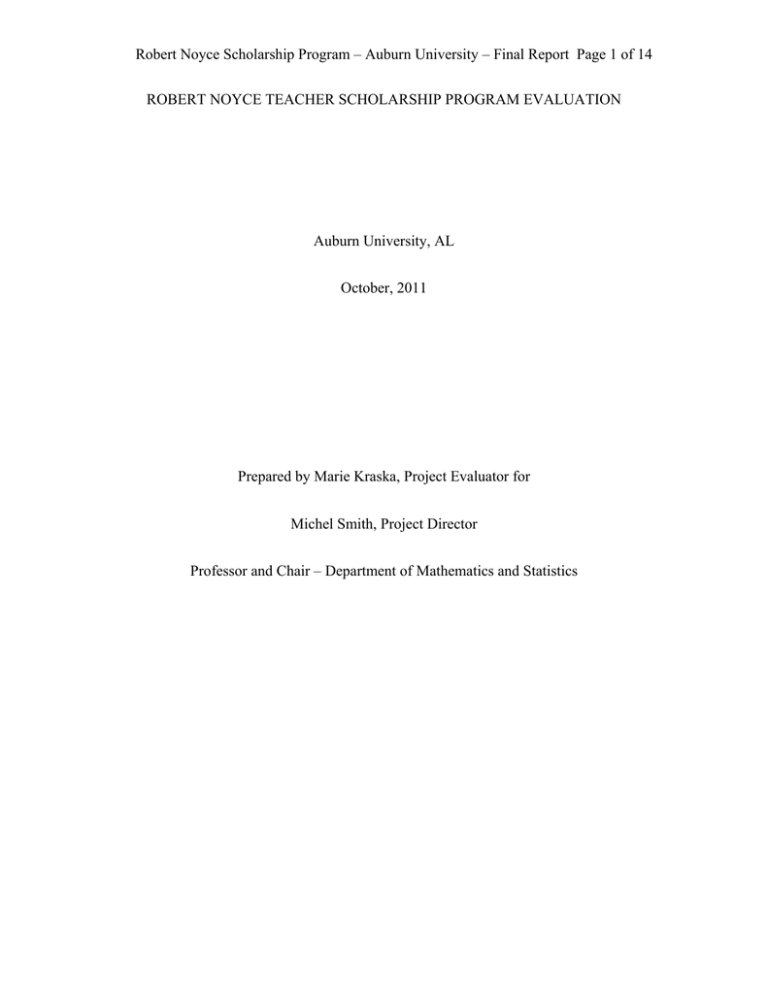
Robert Noyce Scholarship Program – Auburn University – Final Report Page 1 of 14 ROBERT NOYCE TEACHER SCHOLARSHIP PROGRAM EVALUATION Auburn University, AL October, 2011 Prepared by Marie Kraska, Project Evaluator for Michel Smith, Project Director Professor and Chair – Department of Mathematics and Statistics Robert Noyce Scholarship Program – Auburn University – Final Report Page 2 of 14 Noyce Scholarship Program – Final Report This is the five-year final report for the Noyce Scholarship Program. A summary of accomplishments for this last and final year of the project is presented, followed by a synopsis of accomplishments for the entire program. Summary for Last Year of the Project Three students were served during the last year of the program. Two students left the program before graduation for financial reasons. One student became an entrepreneur and opened his own business; the second student left the program for a stipend at another university. Both of these students were in the mathematics education program. For both of the students, the lack of a stipend was a major factor in their decision to leave the program. The third student is currently enrolled in the 5th-year Master’s program in general science education. This is a KoreanAmerican student who came into the program during the Summer of 2011, and became a Noyce scholar in the Fall of 2011. Summary of Program The remaining Noyce scholar initiated the contact for entry into the general science education program. He asked about financial assistance, and the science education professor directed him to the Project Director for the Noyce Scholarship. He applied for the scholarship and was readily accepted. The Noyce scholar’s program in general science education was no different from the program for other general science education students. Like the other students in the program, the Robert Noyce Scholarship Program – Auburn University – Final Report Page 3 of 14 Noyce scholar is currently involved in outreach activities in the elementary and secondary schools to acquire teaching experience. In addition, he taught a few lessons for the Boys and Girls Clubs of America, as well as participated in summer camps for science education. The Noyce scholar’s progress and performance in the general science education program has been outstanding. Currently, this student is enrolled in the Methods of Teaching Science course, which requires that he co-teach in a junior high or high school setting under the direction and supervision of a master teacher. He is teaching biology in a junior high school in Auburn, AL. The student will complete his intern teaching in the Fall of 2012 and be graduated in December, 2012. His plans are to teach chemistry at the high school level. Even though the Noyce program will terminate at the end of the Fall 2011 semester, the current student intends to finish the general science education program. This student holds a Bachelor’s degree in chemical engineering and plans to obtain a Graduate Teaching Assistantship in the Department of Chemistry to support himself until program completion. Robert Noyce Scholarship Program – Auburn University – Final Report Page 4 of 14 Summary of Overall Noyce Program Evaluation The Robert Noyce Scholarship Program was implemented in the Fall of 2006 as a collaborative effort between faculty within the Department of Mathematics and Statistics in the College of Sciences and Mathematics (COSAM) and the Department of Curriculum and Instruction in the College of Education (COE). The common goals of the faculty were to improve mathematics education (and later science education was added) in rural Alabama schools in accordance with the No Child Left Behind legislation by improving the preparation of future teachers of mathematics and sciences. Another goal was to develop sound research-based instruction in mathematics and sciences. The primary focus of the project was to prepare prospective teachers of mathematics and sciences with the necessary content and pedagogical skills to teach mathematics and sciences more effectively at the middle school and secondary school levels. Specifically the existing Fifth Year Master’s program in Secondary Mathematics Education in the Department of Curriculum and Teaching which leads to teacher certification in mathematics served as a springboard for the Noyce Scholarship program. The Fifth Year Master’s program in Secondary Science Education was added to the Noyce Scholarship at a later date. Both of the Fifth Year Master’s programs (mathematics and science) prepare individuals who have the Bachelor’s degree in mathematics or science with the prerequisite knowledge and skills to be effective classroom teachers. Description of the Project The Auburn University Robert Noyce Scholarship Program (AURNSP) provided one year of undergraduate support and one year of graduate support for students who were Robert Noyce Scholarship Program – Auburn University – Final Report Page 5 of 14 completing a Baccalaureate degree in mathematics (and later science) who agreed to apply for and enroll in the appropriate Fifth Year Master’s program. Students who were already enrolled in a Master’s program in mathematics or science were to be provided with two years of support from the AURNSP, as well as teaching assistantships whenever possible. Tuskegee University and twelve local school districts collaborated to redesign the program for the preparation of teachers at partnership higher education institutions. In addition, the AURNSP was interfaced with the National Science Foundation funded program called Transforming East Alabama Mathematics (TEAM-Math) as part of the overall effort to provide classroom and research experiences for the Noyce scholars. Early recruitment efforts included providing early classroom exposure to students majoring in mathematics and who showed interest in teaching mathematics. Male students and African-American students were targeted for recruitment. Of the eleven students who applied initially for the Noyce scholarship during the 2005 to 2009 period, five were male and six were female. Only one female African-American student showed interest in the program; however, this student was not accepted into the program because she was unable to meet the Alabama state requirements for teacher certification. One male is Native American and he completed the program in 2007. During the time period from 2007 to 2009, three male students and one female student completed the program. One male student, a Korean-American is currently enrolled in the program. Recruitment and Retention The Auburn University Robert Noyce Scholarship Program (AURNSP) faced several major challenges for recruitment and retention. First of all, state-wide efforts to attract students Robert Noyce Scholarship Program – Auburn University – Final Report Page 6 of 14 into the Fifth Year Master’s program were not as successful as Auburn University anticipated, probably due to several reasons. Students were concerned about the lack of a stipend during the course of their study. Some students had concerns about the time commitment to required to teach in a high needs area upon completion of their program. Economic concerns played a major role in recruitment and retention of students. The state of Georgia awards the Hope Scholarship to all high school graduates who quality and this scholarship presents hugh competition for students in the mathematics and sciences areas for Auburn University. The financial incentive is stronger in the state of Georgia. For the academic years 2005 through the Fall of 2011, eleven students met the qualifications for the Noyce scholarship, although some of them did not finish their respective program. Currently, five former Noyce scholars are teaching mathematics in a junior high or high school setting. An additional student should be added to this number by the end of Fall semester 2012. Noyce Scholars’ Participation in Mathematics and Science Teacher Preparation Programs Coursework for the Noyce scholars in both the mathematics and science teacher education programs included subjects within the respective disciplines, as well as professional education courses. Formal coursework was supplemented with field-based experiences, use of technology, instructional strategies, and student assessment techniques that are research-based to reflect current practices on the teaching and learning of mathematics and science and best practices in the classroom. Robert Noyce Scholarship Program – Auburn University – Final Report Page 7 of 14 Demographic and Enrollment Information Complete demographic and enrollment information that were collected from the Co-PIs are included in the Robert Noyce Teacher Scholarship Program Evaluation Report for September 2010. Following is a summary of that information. Summary of Comments from Noyce Scholars 1. Most Noyce scholars learned about the program through conversations with faculty members in the Department of Mathematics and Statistics or the Department of Curriculum and Teaching. As part of the recruitment efforts, faculty informed all students about the Noyce scholarship who were enrolled in mathematics (and later science) courses. In addition, a brochure prepared by the Co-PIs was distributed to the students. 2. Noyce scholars reported that the scholarship was influential in their decision to teach. The Noyce scholarship was attractive not only in terms of the financial assistance, but also in terms of the kinds of total educational experiences the Fifth Year Alternative Master’s degree for teacher preparation provided. However, due to economic necessities, some students realized that without a monthly stipend, they would be unable to survive financially with only the Noyce scholarship. Consequently, some students left the program early. 3. To date, four former Noyce scholars have completed the program. They acknowledged that the strengths of typical mathematics courses included the advanced content level of knowledgebased courses and the support and expertise of the mathematics faculty. Noyce scholars completed the same courses that other Fifth Year Alternative Master’s candidates completed. Courses included teaching methods, classroom management, research studies in mathematics, Robert Noyce Scholarship Program – Auburn University – Final Report Page 8 of 14 organization of mathematics programs, technology in the teaching and learning of mathematics, and mathematics program evaluation. In addition, courses in education to address advanced study in exceptionality, literacy and inquiry in mathematics, and advanced study of educational measurement and evaluation. 4. Noyce scholars recognized that the strengths of the typical non-mathematics education courses included the effectiveness and thoroughness with which individuals were prepared to teach in high-needs areas; support and expertise provided by the teacher educators; and the overall preparation of individuals to teach diverse students. Experiences that were especially enlightening for future teachers was preparation in best practices common across various classrooms, common challenges, pressing issues, current research, and future trends in effective teaching. 5. Future teachers of mathematics participated as members of TEAM-Math in quarterly meetings where they could learn about new technology. Noyce scholars interacted with experienced teachers, as well as serve as summer workshop participants. The program provided Noyce scholars with opportunities to teach in high-needs schools. These experiences were invaluable to participants. 6. Evaluation of Noyce scholars’ progress was constant and objective throughout their coursework. Content- based objective tests, as well as professor evaluations of projects, papers, and group assignments were used. This mix of evaluation methods provided a more complete report of student performance and progress. Robert Noyce Scholarship Program – Auburn University – Final Report Page 9 of 14 7. All Noyce scholars reported that the strength of the program was the summer institutes for TEAM Math because the institutes gave students an opportunity to interact with experienced teachers and to hear presentations on the latest teaching methods. 8. A major limitation of the program was the fact that the scholarship was for only one year, whereas the program took one scholar two academic years plus a summer session. In addition, the scholarship did not provide a monthly stipend for students. Another limitation of the program was the small number of scholars. With only two or three scholars at the same point in the program at the same time, students did not have any peers with whom they could study and relate common goals, interests, and concerns. 9. Long range plans for scholars who completed their respective program is to teach mathematics (science in one case) in a junior high or high school setting. Summary of Comments from Cooperating Teachers 1. Teacher responses were very positive with regard to questions based on the intern’s performance. Teachers indicated that they did not receive information about the Noyce scholarship program, so responses were based on the student’s performance and not whether the intern was a Noyce scholar. Interns taught different subjects and grade levels that ranged from 7th to 8th grade prealgebra to 8th grade geometry to 8th grade introduction to algebra. 2. The number of years of teaching experience for teachers who were supervising interns ranged from 5 years to 15 years. 3. Teachers agreed that all the teaching interns they supervised from Auburn University were all prepared to teach in high-needs areas whether or not the student was a Noyce scholar, and all Robert Noyce Scholarship Program – Auburn University – Final Report Page 10 of 14 teachers agreed that the Noyce scholar demonstrated excellent mastery of the subject matter. In addition, teachers reported that the students understood and implemented cutting-edge methods for teaching mathematics, such as using models and real-life problems. 4. Cooperating teachers indicated a very positive relationship with the university and the faculty in the Department of Mathematics and the faculty in the Mathematics Education Program within the Department of Curriculum and Instruction. 5. Cooperating teachers had no specific recommendations for program improvement, as all of them were highly complementary of the faculty and students involved in the fifth-year master’s program in mathematics at Auburn University. Some teachers suggested that recruitment of individuals with a degree in mathematics for the fifth-year master’s program would strengthen the skills of future teachers of mathematics. Summary of Responses from the Co-PIs Three of the four Co-PIs provided input for this final report. 1. The Co-PIs stated that specific components of the recruitment program included informal talks with principals, talks with promising students, and a brochure informing interested students about the program. 2. The Co-PIs recognized that the HOPE scholarship in the state of Georgia had the competitive edge in recruiting undergraduate students within the state of Alabama. Consequently, no undergraduate students within the state of Alabama participated in the program. 3. All of the Noyce scholars participated in the summer institute for TEAM Math. Most of the students helped to facilitate the workshop; one Noyce scholar was a presenter at three of the Robert Noyce Scholarship Program – Auburn University – Final Report Page 11 of 14 summer institutes. One Noyce scholar participated in summer camps for science students and in teaching activities for the Boys and Girls Clubs of America. 4. All of the Noyce scholars participated in the TEAM Math summer institutes, Team Math workshops, and quality weekend meetings to interact with in-service teachers from other schools. Also, a Malone Family Foundation grant was received to help TEAM Math schools integrate technology. Noyce scholars had opportunities during the workshops to learn how to integrate new technology into their teaching. 5. Noyce scholars were observed during their internships by faculty from the Mathematics Education Program. Initial visits were conducted to explain the role of students and cooperating teachers and the expectations of the University. 6. The Co-PIs agreed that the teacher candidates were a major strength of the program. These individuals showed a strong commitment to the teaching profession through their performance in the alternative (53-semester hour) master’s program. Other strengths of the program were the integration of the Noyce scholars into courses with experienced teachers as well as with undergraduates, and also the inclusion of the scholars with TEAM Math, summer camps, and other activities. 7. The Co-PIs stated that recruitment of qualified students was a major challenge, not only because of competition with the HOPE scholarship in the state of Georgia, but also with identification of potential scholars from the College of Science and Mathematics (COSAM) who were interested in teaching and who were willing to fulfill the requirement of teaching in a high needs area for a period of time. Robert Noyce Scholarship Program – Auburn University – Final Report Page 12 of 14 Appendix A AURNSP Scholar Follow-up Questionnaire 1. How were you informed about the program or recruited into the program? 2. How influential was the Noyce scholarship program in your decision to teach? 3. When did you apply for the program? 4. Did you complete the program? If so, when? 5. How would you describe your typical mathematics courses? 6. What kinds of courses did you take that supported your mathematics content courses? 7. How would you describe your typical non-mathematics courses? 8. What were the strengths of the Noyce scholarship program? 9. How would you describe evaluation of your progress throughout the program? 10. How would you describe special strengths of the program? 11. How would you describe any limitations of the program? 12. What are your long-range career plans? Robert Noyce Scholarship Program – Auburn University – Final Report Page 13 of 14 Appendix B AURNSP Follow-Up Questionnaire for Cooperating Teachers 1. Have you supervised teaching interns in the past? 2. Which subjects and grade levels did your intern teach? 3. What is your impression of the Preparation of Noyce scholars to teach in high needs areas compared with teachers not prepared to teach in high-needs areas? 4. What was your impression of the Noyce scholar’s mastery of the subject matter? 5. What was your impression of the Noyce scholar’s pedagogical ability? 6. How would you describe your relationship with the university? 7. What recommendations do you have to improve the preparation of teachers of mathematics? Robert Noyce Scholarship Program – Auburn University – Final Report Page 14 of 14 Appendix C AURNSP Follow-Up Questionnaire for Co-PI’s 1. What were the specific components of the recruitment program? 2. How many undergraduate students participated in the program? 3. How many Noyce scholars participated in mentoring workshops developed by TEAM Math for beginning mathematics teachers? 4. In what kinds of mentoring workshops did Noyce scholars participate? 5. Were regular observations of the Noyce scholars conducted during their internships? 6. What were the strengths of the Noyce Scholarship Program? 7. What were the challenges of the Noyce Scholarship Program and areas for improvement?
